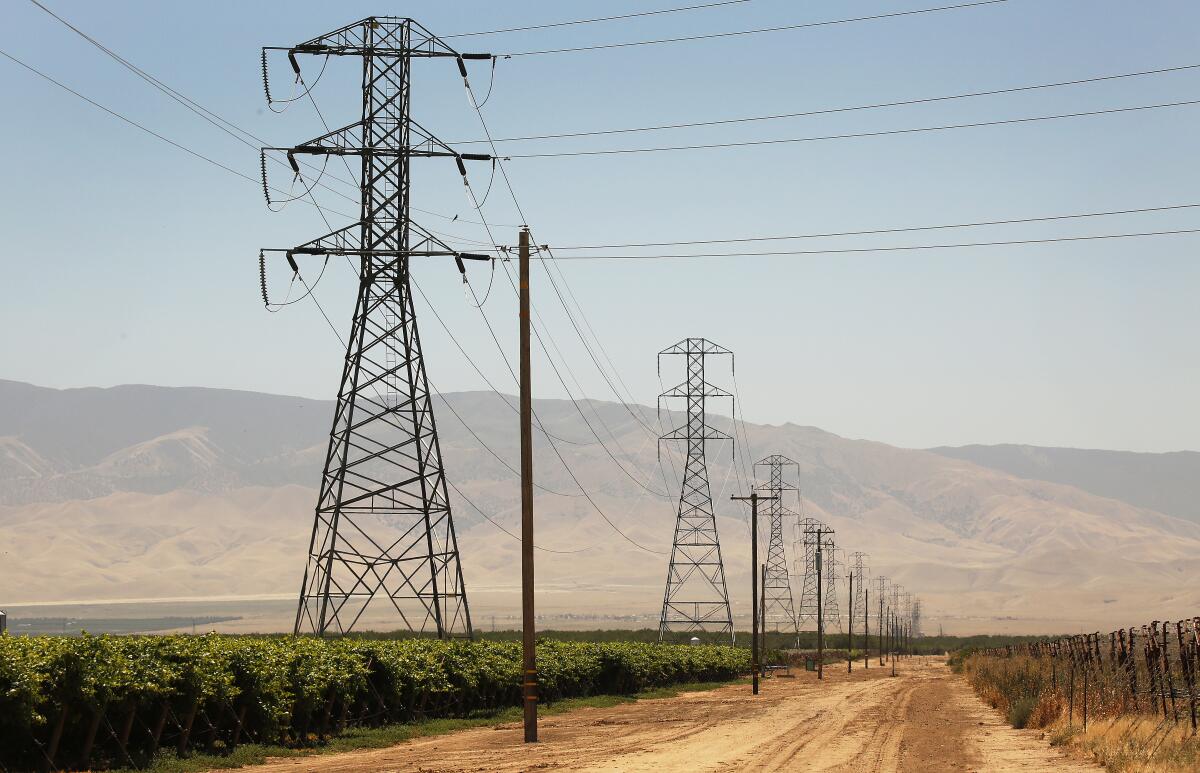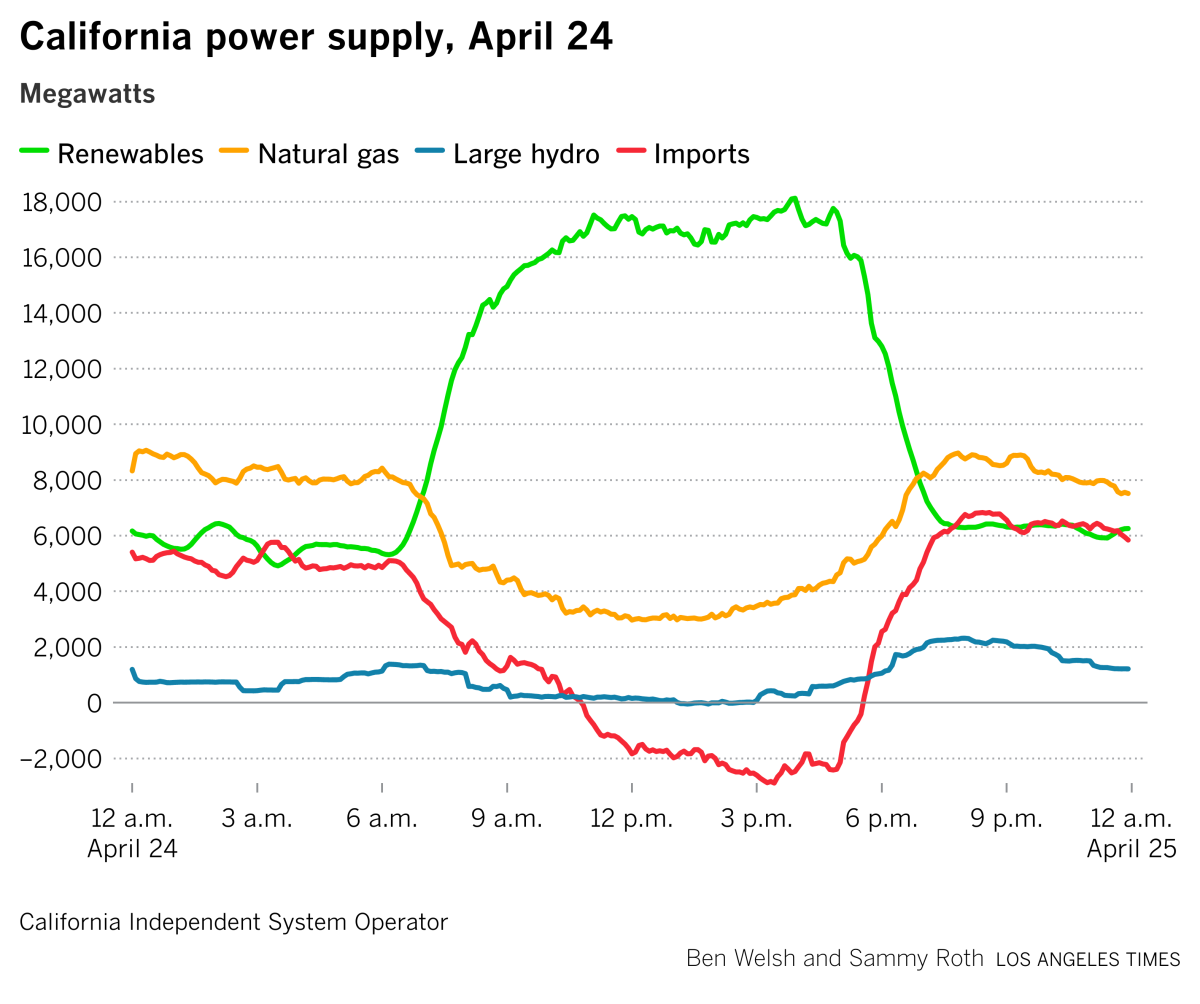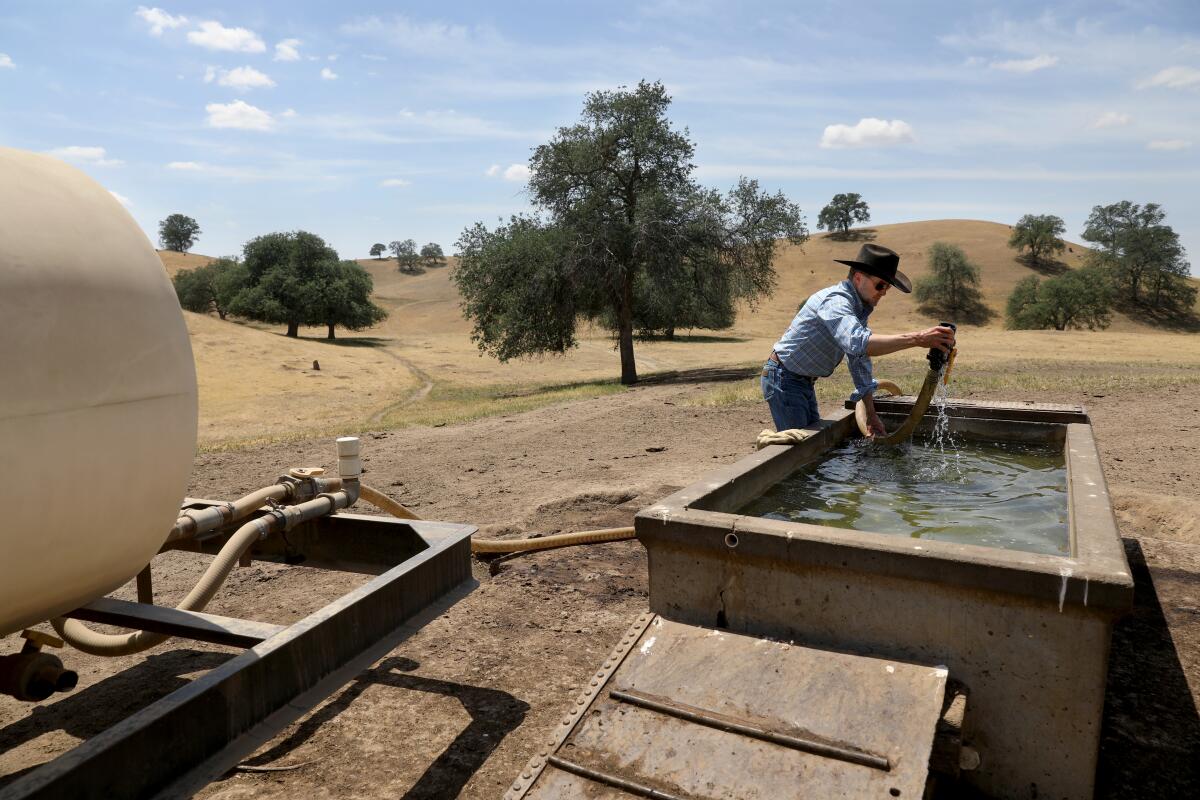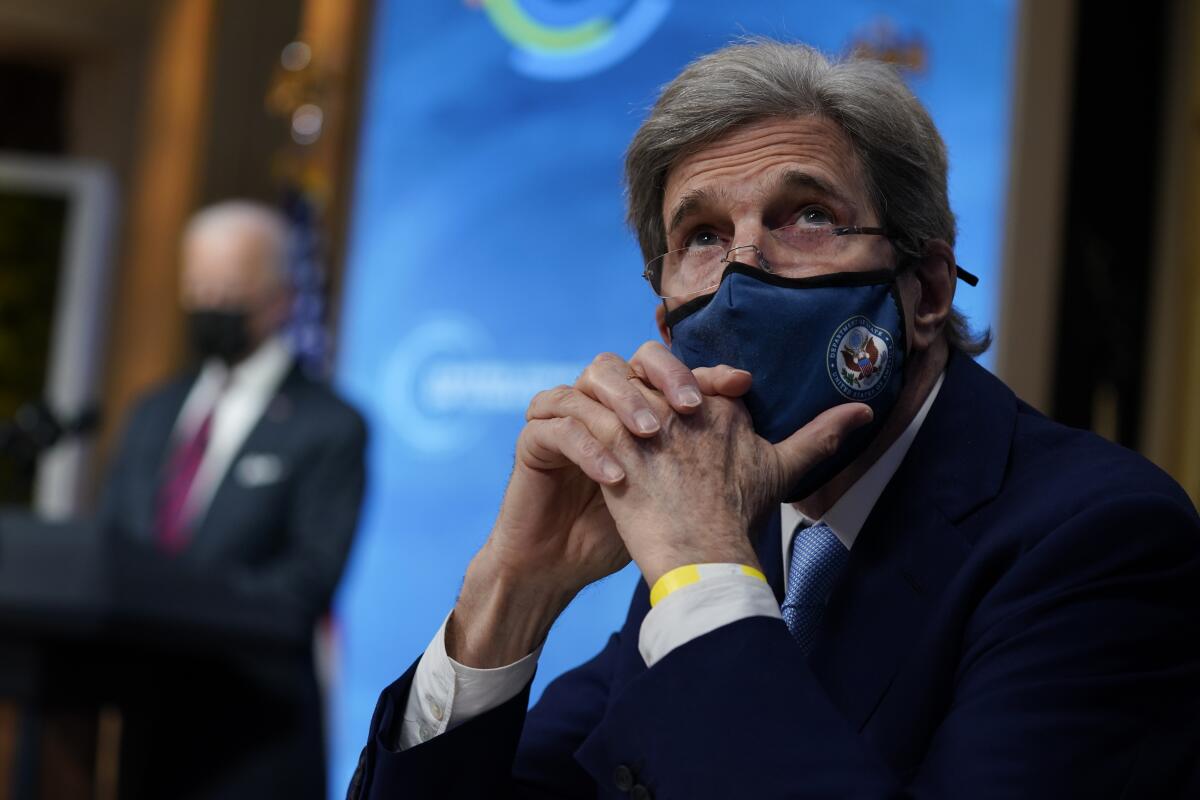California just hit 95% renewable energy. Will other states come along for the ride?

- Share via
This is the April 29, 2021, edition of Boiling Point, a weekly newsletter about climate change and the environment in California and the American West. Sign up here to get it in your inbox.
Something remarkable happened over the weekend: California hit nearly 95% renewable energy.
I’ll say it again: 95% renewables. For all the time we spend talking about how to reach 100% clean power, it sometimes seems like a faraway proposition, whether the timeframe is California’s 2045 target or President Biden’s more aggressive 2035 goal. But on Saturday just before 2:30 p.m., one of the world’s largest economies came within a stone’s throw of getting there.
There are several caveats. For one thing, Saturday’s 94.5% figure — a record, as confirmed to me by the California Independent System Operator — was fleeting, lasting just four seconds. It was specific to the state’s main power grid, which covers four-fifths of California but doesn’t include Los Angeles, Sacramento and several other regions. It came at a time of year defined by abundant sunshine and relatively cool weather, meaning it’s easier for renewable power to do the job traditionally done by fossil fuels.
And fossil fuels actually were doing part of the job — more than the 94.5% figure might suggest. California was producing enough clean power to supply nearly 95% of its in-state needs, but it was also burning a bunch of natural gas and exporting electricity to its Western neighbors. It’s impossible to say exactly how much of the Golden State’s own supply was coming from renewables.
That said, what happened on Saturday is definitely a big deal.
“It sends chills down my spine. It’s amazing,” said Elliot Mainzer, president and CEO of the California Independent System Operator, which runs the state’s main power grid. “These types of transitions aren’t always pretty. But we’re getting a lot of renewable generation online, making a real dent in the state’s carbon emissions.”
I’ll get to the bit about the transition not always being pretty in a minute. For now, here’s a chart based on data from the grid operator’s website, showing how various sources of power supply changed hour by hour on Saturday:

That green line at the top is renewables; you can see how it jumps up in the morning and falls in the evening, reflecting sunrise and sunset. The orange line under that is natural gas. The red line at the bottom is out-of-state imports. It sinks into negative territory in the middle of the day because California has so much solar power that it’s selling some to other states.
The 94.5% record may have been fleeting, but it wasn’t some isolated spike. Most of Saturday afternoon, the renewables number topped 90%, with solar and wind farms doing the bulk of the work and geothermal, biomass and hydropower facilities making smaller contributions. Add in the Diablo Canyon nuclear plant — which isn’t counted toward California’s renewables mandate — and there was enough climate-friendly power at times Saturday to account for more than 100% of the state’s electricity needs.
So California has lots of clean power. The important thing now is making sure the puzzle pieces of the grid fit together on hot summer evenings, like the ones last August when insufficient supplies after sundown led to rolling blackouts.
State officials are taking many steps to avoid a repeat of last summer’s emergency, some of which are more controversial than others. They’re also beginning to focus on the longer term. Mainzer’s grid operator recently urged the California Public Utilities Commission to order electric companies to add 10,000 megawatts of power by 2026 — about one-eighth of the state’s entire generating capacity! — in part to make sure there’s enough supply on the grid when the Diablo Canyon nuclear plant closes.
“That’s not an inconsequential investment,” Mainzer said.
No, it’s most definitely not. But while some of the clean energy solutions California is almost certain to need will carry a high upfront price tag, others are much less expensive. In fact, some produce immediate savings.
Case in point: the Western Energy Imbalance Market.
I’ve avoided writing too much about the Western EIM (acronym alert!) because it gets very wonky, very fast. But it’s absolutely worth knowing about. It’s a unique program that makes it easier for utility companies across the American West to share extra electricity, with a goal of saving money for ratepayers (i.e. you and me) and reducing planet-warming emissions.
How does it work? As I explained in a 2017 deep dive for the Desert Sun, the program allows out-of-state utilities to participate in California’s real-time electricity market, where they can buy power to fill in last-minute gaps between supply and demand.
So if California has more solar power than it can use on a sunny afternoon — a growing trend each spring — it can send some of that cheap electricity to Arizona, which then might be able to burn less coal. Or if the wind is ripping in Wyoming — home to some of the country’s strongest, most consistent gusts — California can tap into that clean power rather than firing up a gas plant.
A key barrier to this type of cooperation in the past was mistrust: Red states worried about blue states shoving renewable energy down their throats, and blue states worried about red states forcing them to buy dirty energy. And nobody wanted to risk finding themselves short on electricity in a pinch because some out-of-state utility made a higher bid for their power.
But in the seven years since California launched the Western EIM, that mistrust has started to fade.
There are now 14 electric grid operators participating in the imbalance market, from Arizona Public Service in the Southwest to Idaho Power in the Northwest to Warren Buffett-owned Rocky Mountain Power in the Intermountain West. Several utilities joined this month, including the Los Angeles Department of Water and Power, which has long zealously guarded its independence. Several more are preparing to join, as far from California as NorthWestern Energy in Montana and El Paso Electric in Texas.
By 2023, the market will cover 83% of electricity demand in the West. Here’s a map of the current and planned participants:
The program is growing so fast in part because of the measurable economic benefits. Through the end of 2020, participants collectively saved nearly $1.2 billion. Mainzer told me another $101 million in savings accrued in the first quarter of this year.
“California has seen about $300 million of those benefits, and the state hasn’t had to pay a penny to see that market get up and running,” he said. “It’s just been a smashing success.”
At the same time, political obstacles still stand in the way of a fully integrated Western power grid that could do a whole lot more to limit costs, reduce climate pollution and ultimately prevent power outages — “one grid to rule them all,” to borrow a phrase I first saw used by Utility Dive journalist Herman K. Trabish.
Three years of discussion over expanding the EIM, for instance, have not yet resulted in an agreement among the participants. A proposal from then-Gov. Jerry Brown that would have transitioned California’s grid operator to a truly regional power authority — again, see my 2017 deep dive — was defeated several times in the state Legislature, amid opposition from lawmakers who worried the plan would result in fewer in-state jobs and cede too much power over California’s energy mix to other states.
Some of those other states are similarly wary of Mainzer’s Independent System Operator, which is led by appointees of the California governor. The agency’s primary responsibility is serving Californians, even as it runs the EIM for the whole region.
Those tensions came to a head last week when the grid operator’s leaders voted to prioritize California’s electricity needs during crunch times on the grid this summer, to the possible detriment of out-of-state utilities that typically have been able to send energy through California’s power lines without much trouble. Arizona and Nevada’s major utilities wrote that the plan was “not equitable or fair.” Mainzer’s former employer, the Portland-based Bonneville Power Administration, wasn’t happy either.
“We take our obligations to California dead seriously,” Mainzer said.
At the same time, he added, “we definitely are very motivated to help the broader West.” As California should be. The state won’t make much of a difference on climate change unless it can bring the rest of the country and world along for the ride.
At the moment, Mainzer is focused on keeping the lights on this summer. He’s also happy to celebrate the 95% renewable energy record, even if only for a moment.
“We have to remember the positives of the story as well,” he said.
And now, here’s what else is happening around the West:
TOP STORIES

There’s a growing recognition in California’s Central Valley that the farm economy will shrink as droughts worsen and farmers face the consequences of pumping too much groundwater. That’s one takeaway from this story by my colleague Louis Sahagún, who wrote about how farmers and farmworkers are affected by increasingly scarce (and often polluted) water supplies, including many Latino families who face the risk of their drinking-water wells running dry. Columnist Michael Hiltzik, meanwhile, writes that westerners must come to terms with what John Wesley Powell told a Los Angeles irrigation conference in 1893: “You are piling up a heritage of conflict and litigation over water rights, for there is not sufficient water to supply the land.”
President Biden’s new climate target is more ambitious than California’s. Biden pledged that the United States will slash its planet-warming pollution at least 50% below 2005 levels by 2030, compared to the 47% the Golden State is aiming for, as Tony Barboza reports for The Times. (Tony also compiled a brief history of U.S. climate pledges.) America’s new goal is roughly double what President Obama had sought to achieve, per The Times’ Chris Megerian. Biden ended his climate summit last week by making the case that global warming is a challenge but also an economic opportunity, my colleague Anna M. Phillips reports.
Lest he be one-upped by Biden, Gov. Gavin Newsom announced that California would study phasing out all oil production by 2045. He also said the state will stop issuing new fracking permits by 2024, Phil Willon and Taryn Luna report for The Times. By way of context, fracking accounts for a tiny fraction of oil and gas extraction in California; ending oil production would be a much bigger deal. See also my story from last week on scientists who say the state is falling behind on climate leadership.
At this point, it seems like almost a given that California will see another historic fire season. So writes our new wildfire reporter, Alex Wigglesworth, in this piece previewing what we might face in a few short months. The short version: Nobody knows exactly how bad things will be, but a combination of meager rainfall, depleted snowpack and dry vegetation spells trouble.
WATER IN THE WEST
Toward a more sustainable California
Get Boiling Point, our newsletter exploring climate change, energy and the environment, and become part of the conversation — and the solution.
You may occasionally receive promotional content from the Los Angeles Times.
A stunning DDT dump site off the coast of Los Angeles is much bigger than scientists expected. My colleague Rosanna Xia writes that scientists aboard the research vessel Sally Ride were so overwhelmed by the images sent up by deep-sea robots that it was like “trying to count stars in the Milky Way.” The research mission was prompted by Rosanna’s incredible reporting on the hidden history of the country’s largest DDT manufacturer dumping its pesticide waste into the Pacific Ocean.
California officials are poised to order Nestlé to stop bottling and selling millions of gallons of water from San Bernardino National Forest. The proposed order comes six years after reporter Ian James revealed that the company was taking water from the national forest under a permit that was supposed to expire in 1988. Here’s the latest on what happens next from Ian and Janet Wilson at the Desert Sun. (Ian also has a scary piece for the Arizona Republic on the state of play on the Colorado River, including the fact that Lake Powell could dip low enough in the next few years that it stops being able to generate hydropower.)
Water regulators continue to debate a proposed desalination plant in Huntington Beach. The facility faces all the usual tensions: It would generate clean drinking water while using lots of energy and harming marine life, as Bettina Boxall reports for The Times. One outstanding question is whether the developer, Poseidon Water, shouldn’t be allowed to sell water until it’s ready to start its environmental mitigation work, which includes wetlands restoration at the nearby Bolsa Chica Ecological Reserve.
A Texas-based group is pushing county governments in Colorado and other states to pass resolutions opposing Biden’s goal of protecting 30% of U.S. lands and waters by 2030. The hard-right American Stewards of Liberty was founded by the daughter of some of the original Sagebrush Rebels. She argues that the “30 by 30” goal — which was also endorsed by Gov. Gavin Newsom — is “anti-capitalism,” “anti-individual liberty” and “anti-American,” as Nancy Lofholm reports for the Colorado Sun.
POLITICAL CLIMATE

President Biden’s climate summit did not yield new commitments from most of the world’s major polluters. One exception was South Korea, which pledged to stop financing new overseas coal plants, as Chris Megerian and Anna M. Phillips report for The Times. Anna also put together a helpful rundown on how the world’s biggest emitters are doing on their existing climate pledges.
Back at home, the White House bolstered its own climate pledge by announcing it would push for a law requiring 80% clean electricity nationwide by 2030. A new analysis from researchers at Energy Innovation and UC Berkeley concludes that target is feasible, per Reuters’ Valerie Volcovici and Nichola Groom. Reuters’ Timothy Gardner also reports that the Biden administration will offer more than $8 billion in loans to support clean energy by expanding and upgrading the power grid.
The Biden administration is also proposing to once again allow California to set its own tailpipe pollution rules. This was expected, but it’s still a big deal for getting America’s largest source of climate pollution under control, Anna M. Phillips reports. L.A. Times columnist Michael Hiltzik, meanwhile, explores a new report from the Environmental Protection Agency’s inspector general finding the Trump administration deliberately locked out EPA scientists as it weakened tailpipe emissions rules.
“Too many people drive like demons because they think they won’t get caught. Knowing they might be on camera could help reduce the carnage.” That’s Times columnist Steve Lopez making the case for two bills in Sacramento that would seek to slow down drivers by allowing automated speeding enforcement. You’ll remember my recent piece about my friend Jim Pagels, who was killed in a car crash after years of advocating for safer streets that work for cyclists and pedestrians, not just drivers.
THE ENERGY TRANSITION
REI says climate change is an existential threat — but it spent Earth Month helping Ford market a gas-guzzling SUV. The outdoor recreation company has made environmental stewardship a core part of its branding, but that didn’t stop it from making ads promoting the Bronco Sport, and alerting its members with the email subject line “Load Up. Gas Up. Get Out,” per my story for The Times. I also learned that REI’s director of sustainability said he was “not aware of the advertisement before its release.”
A new United Nations report says reducing methane emissions from oil and gas infrastructure is one of the best ways to keep the planet from heating up too quickly. More details here from Hiroko Tabuchi at the New York Times. In related news, the U.S. Senate voted 52-42 to reinstate Obama-era methane restrictions, per my colleagues Sarah D. Wire and Anna M. Phillips.
Natural gas utilities are happy to slash methane emissions, but they’ve fought efforts to phase out gas in favor of clean electricity, arguing they can be part of the long-term climate solution. San Diego Gas & Electric just pledged to achieve net-zero emissions by 2045, joining its corporate sibling, Southern California Gas, as Rob Nikolewski reports for the San Diego Union-Tribune. It’s not yet clear how either utility will reach that target. In the meantime, parent company Sempra Energy continues to seek Biden administration approval for a natural gas export terminal in Mexico, as I reported earlier this year.
Here in Southern California, a natural gas leak in Downey prompted a small evacuation Thursday after a SoCalGas pipeline was cut by a contractor in a residential area. Read more here, from The Times’ Priscella Vega and me. Further south, L.A. City Council member Joe Buscaino is urging the owner of a liquid butane storage facility in San Pedro to sell the site, my colleague Emily Alpert Reyes reports. Local residents have worried for decades that the storage tanks could explode and start a fire.
ONE MORE THING

Let’s end with some pictures. If you want to wallow in California’s latest drought — or if you just like good drone photography — check out this series of images by Getty’s Justin Sullivan showing how much water levels have fallen at Lake Oroville.
If you’d prefer to be inspired, try this lovely Yosemite photo essay by The Times’ Carolyn Cole. One year after pandemic safety precautions shut down the national park and let the animals take over, humans are back. And they’re having a great time.
We’ll be back in your inbox next week. If you enjoyed this newsletter, please consider forwarding it to your friends and colleagues.




